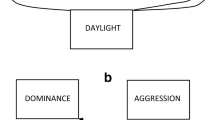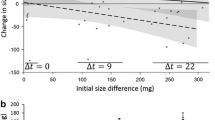Synopsis
In laboratory experiments, we contrasted the behavior of juvenile walleye pollock under dark and light conditions, comparing group cohesion, activity levels, vertical distribution, and movement into cold water when the water column was thermally stratified. At night the fish displayed a tendency for movement into the upper water column and were less active, with groups more dispersed than during the day. Time spent in cold water under stratified conditions did not differ between day and night. These results are interpreted relative to the potential ecological benefits and costs of particular behaviors, and their application in designing effective sampling surveys of juvenile abundances.
Similar content being viewed by others
References cited
Ali, M.A. 1992. Rhythms in fishes. Plenum Press, New York. 348 pp.
Allen, L.G. & E.E. DeMartini. 1983. Temporal and spatial patterns of nearshore distribution and abundance of the pelagic fishes off San Onofre-Oceanside, California. U.S. Fish. Bull. 81: 569–586.
Appenzelier, A.R. & W.C. Leggett. 1992. Bias in hydroacoustic estimates of fish abundance due to acoustic shadowing: evidence from day-night surveys of vertically migrating fish. Can. J. Fish. Aquat. Sci. 49: 2179–2189.
Bailey, K.M. 1989. Interaction between the vertical distribution of juvenile walleye pollockTheragra chalcogramma in the eastern Bering Sea and cannibalism. Mar. Ecol. Prog. Ser. 53: 205–213.
Bailey, K.M. & S.M. Spring. 1992. Comparison of larval, age-0 juvenile and age-2 recruit abundance indices of walleye pollock,Theragra chalcogramma, in the western Gulf of Alaska. ICES J. Mar. Sci. 49: 297–304.
Baird, T.A., C.H. Ryer & B.L. Olla. 1991. Social enhancement of foraging on an ephemeral food source in juvenile walleye pollock,Theragra chalcogramma. Env. Biol. Fish. 31: 307–311.
Blaxter, J.H.S. & B.B. Parrish. 1965. The importance of light in shoaling, avoidance of nets and vertical migration by herring. J. Conseil Int. Explor. Mer. 30: 40–57.
Bohl, E. 1980. Die] pattern of pelagic distribution and feeding in planktivorous fish. Oecologia 44: 368–375.
Brodeur, R.D. & M.T. Wilson. 1996. Mesoscale acoustic patterns of juvenile walleye pollock (Theragra chalcogramma) in the western Gulf of Alaska. Can. J. Fish. Aquat. Sci. (in press).
Cerri, R.D. 1983. The effect of light intensity on predator and prey behaviour in cyprinid fish: factors that influence prey risk. Anim. Behav. 31: 736–742.
Clark, P.J. & F.C. Evans. 1954. Distance to nearest neighbor as a measure of spatial relationships in populations. Ecology 35: 445–453.
Davis, M.W. & B.L. Olla. 1992. The role of visual cues in the facilitation of growth in a schooling fish. Env. Biol. Fish. 34: 421–424.
Dembinski, W. 1971. Vertical distribution of vendaceCoregonus albula L. and other pelagic fish species in some Polish lakes. J. Fish Biol. 3: 341–357.
Emery, A.R. 1973. Preliminary comparisons of day and night habits of freshwater fish in Ontario lakes. J. Fish. Res. Board Can. 30: 761–774.
Fraser, N.H.C., N.B. Metcalfe & J.E. Thorpe. 1993. Temperature dependent switch between diurnal and nocturnal foraging in salmon. Proc. R. Soc. Lond. B 252: 135–139.
Frost, K.J. & L.F. Lowry. 1981. Trophic importance of some marine gadids in northern Alaska and their body-otolith size relationships. U.S. Fish. Bull. 79: 187–192.
Haldorson, L., M. Prichett, A.J. Paul & D. Ziemann. 1993. Vertical distribution and migration of fish larvae in a Northeast Pacific bay. Mar. Ecol. Prog. Ser. 101: 67–80.
Helfman, G.S. 1993. Fish behaviour by day, night and twilight. pp. 479–512. In: T.J. Pitcher (ed.) Behaviour of Teleost Fishes. Chapman and Hall, London.
Kavaliers, M. 1980. Social groupings and circadian activity of the killifish,Fundulus heteroclitus. Biol. Bull. 158: 69–76.
Kendall, A.W.J., L.S. Incze, P.B. Ortner, S.R. Cummings & P.K. Brown. 1994. The vertical distribution of eggs and larvae of walleye pollock,Theragra chalcogramma, in Shelikof Strait, Gulf of Alaska. U.S. Fish. Bull. 92: 540–554.
Koeller, P.A., P.C.F. Hurley, P. Perley & J.D. Neilson. 1986. Juvenile fish surveys on the Scotian Shelf: implications for year-class size assessments. J. Conseil Int. Explor. Mer. 43: 59–76.
Livingston, P.A. 1993. Importance of predation by groundfish, marine mammals and birds on walleye pollockTheragra chalcogramma and Pacific herringClupea pallasi in the eastern Bering Sea. Mar. Ecol. Prog. Ser. 102: 205–215.
Neilson, J.D. & R.I. Perry. 1990. Diel vertical migrations of marine fishes: an obligate or facultative process? pp. 115–168. In: J.H.S. Blaxter & A.J. Southward (ed.) Advances in Marine Biology, Academic Press, London.
Olla, B.L. & M.W. Davis. 1990a. Effects of physical factors on the vertical distribution of larval walleye pollockTheragra chalcogramma under controlled laboratory conditions. Mar. Ecol. Prog. Ser. 63: 105–112.
Olla, B.L. & M.W. Davis. 1990b. Behavioral responses of juvenile walleye pollockTheragra chalcogramma Pallas to light, thermoclines and food: possible role in vertical distribution. J. exp. mar. Biol. Ecol. 135: 59–68.
Olla, B.L. & C. Samet. 1974. Fish-to-fish attraction and the facilitation of feeding behavior as mediated by visual stimuli in striped mullet,Mugil cephalus. J. Fish. Res. Board Can. 31: 1621–1630.
Olla, B.L. & A.L. Studholme. 1972. Daily and seasonal rhythms of activity in the bluefish (Pomatomus saltatrix). pp. 303–326. In: H.E. Winn & B.L. Olla (ed.) Behavior of Marine Animals: Current Perspectives in Research, Plenum Press, New York.
Pitcher, T.J. & J.K. Parrish. 1993. Functions of shoaling behaviour in teleosts. pp. 363–439. In: T.J. Pitcher (ed.) Behaviour of Teleost Fishes, Chapman & Hall, London.
Pitcher, T.J., A.E. Magurran & I.J. Winfield. 1982. Fish in larger shoals find food faster. Behav. Ecol. Sociobiol. 10: 149–151.
Ryer, C.H. & B.L. Olla. 1992. Social mechanisms facilitating exploitation of spatially variable ephemeral food patches in a pelagic marine fish. Anim. Behav. 44: 69–74.
Sinclair, E., T. Loughlin & W. Pearcy. 1993. Prey selection by northern fur seals (Callorhinus ursinus) in the eastern Bering Sea. U.S. Fish. Bull. 92: 144–156.
Smith, G.W., C.W. Glass, A.D.F. Johnstone & W.R. Mojsiewicz. 1993. Diurnal patterns in the spatial relationships between saithe,Pollachius virens, schooling in the wild. J. Fish Biol. 43: 315–325.
Sogard, S.M. & B.L. Olla. 1993. Effects of light, thermoclines and predator presence on vertical distribution and behavioral interactions of juvenile walleye pollock,Theragra chalcogramma Pallas. J. exp. mar. Biol. Ecol. 167: 179–195.
Sogard, S.M. & B.L. Olla. 1996. Food deprivation affects vertical distribution and activity of a marine fish in a thermal gradient: potential energy conserving mechanisms. Mar. Ecol. Prog. Ser. (in press).
Street, N.G. & P.J.B. Hart. 1985. Group size and patch location by the stoneloach,Noemacheilus barbatulus, a non-visually foraging predator. J. Fish Biol. 217: 785–792.
Author information
Authors and Affiliations
Rights and permissions
About this article
Cite this article
Sogard, S.M., Olla, B.L. Diel patterns of behavior in juvenile walleye pollock,Theragra chalcogramma . Environ Biol Fish 47, 379–386 (1996). https://doi.org/10.1007/BF00005051
Received:
Accepted:
Issue Date:
DOI: https://doi.org/10.1007/BF00005051




